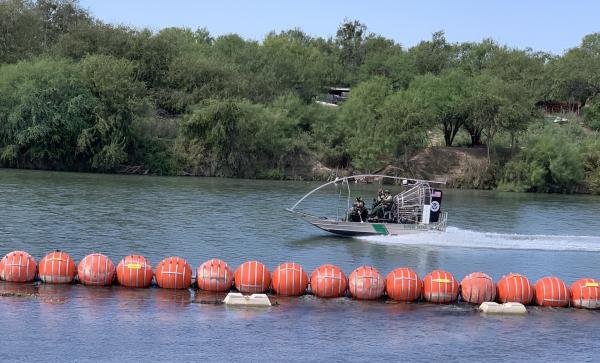Troubled Waters - Recent Challenges to the 1970 US-Mexico Boundary Treaty
8 Mar 2024 by The Water Diplomat

In a research paper published by Rice University’s Baker Institute for Public Policy on the 8th of February, Professor Stephen Mumme and researcher Regina Buono analyse recent challenges to the 1970 U.S.-Mexico Boundary Treaty. This treaty sets out the framework for transboundary cooperation between the two countries on the shared waters of the Rio Grande and Colorado rivers. It also responded to a number of challenges in defining the precise border between the two countries and clarifying the sovereign limits of each. However, recently, in a way that was probably never envisaged by the negotiators of the treaty, initiatives taken by the Governor of Texas in relation to border security have led to legal challenges by the United States Department of Justice (DoJ).
The measures taken by Texas involved the placement of a chain of giant spherical buoys in the center of the Rio Grande as well as shipping containers and concertina wire along the banks of the river to deter unauthorized entry into Texas. However, the placement of the buoys led to complaints from Mexico and the International Boundary and Water Commission (IWBC) related to the prohibition in the treaty against altering of the flow of the river. Established in 1889, the IBWC is the organ responsible for applying the boundary and water treaties between the United States and Mexico and settling differences that may arise in their application. In 2008, already, border security related plans to construct concrete barriers on the top of lower Rio Grande levees as well as through floodplains met with concerns that the barriers would exacerbate flooding of the river if it occurred.
In terms of the 1970 boundary treaty, both in the case of the Rio Grande and in the case of the Colorado, the boundary between the United States and Mexico is set by the deepest channel of the river. However, the dynamic and changing nature of the rivers has meant that tracts of land have been swapped between the countries, and that there have been different interpretations of what constitutes a ‘major change’ to the course of the river in question changes to the river. Since 1944, the IWBC has been empowered with the authority to interpret and apply all boundary and water treaties in force between the two countries.
Within the 1970 treaty, article IV is relevant to the current challenges in that it obliges the governments to prohibit the construction of works that would deflect or obstruct the flow of the river to the disadvantage of the other country. Similarly, the two governments are under obligation to remove or modify works that do cause damage and repair or make compensation for any damage resulting from those works. Each country is permitted to construct works for the stabilisation of the riverbanks on condition that they do not have an adverse effect on the other country or deflect the location of the boundary.
In 2011, the Mexican section of the IBWC reacted to designs by the Department of Homeland Security (DHS) for the construction of barriers adjacent to the Rio Grande in Hidalgo and Starr counties, arguing that they would constitute a serious obstruction and deflection of the flows of the Rio Grande. However, the U.S. section of the IBWC responded that their diagnostics indicated that no deflection would be caused by the construction. When, in 2019, a private construction company moved ahead with constructions in spite of objections from the Mexican parties that their hydraulic impact assessment was flawed, the U.S. section of the IBWC the filed a lawsuit with the Southern District of Texas claiming a treaty violation.
It is against this background that in 2023, when Texas’ Governor Abbot announced a plan to place a chain of giant spherical buoys in the center of the Rio Grande, the IBWC determined that the buoys would intrude on Mexico’s sovereign domain, while submerged skirts could trap debris and alter the river’s flow. A Mexican team was sent to verify whether the buoys did infringe on Mexican territory and found that indeed it did.
At this point, the U.S. Department of Justice (DOJ) then sued Texas, referring amongst others to potential infringements of the 1970 Treaty. On the 6th of September 2023, a federal judge of the U.S. Western District in Austin, Texas, ordered the removal of the buoys, siding with the Department of Justice. The State of Texas responded by appealing the decision, submitting it to the U.S, Court of Appeals, where the case will be heard in May this year.
The authors of the report point to the unique role of the 1970 Treaty in developing and cementing the bilateral relationship between Mexico and the United States, as well as its role in bringing confidence to both parties on their territorial sovereignity and joint management of riparian boundaries. The IWBC, also, is an important binational institution, which consults subnational entities in the management of the boundaries and the water resources shared by the two countries. Challenges to this authority are, they argue, short sighted because of their potential to fan dispute between the countries over the implementation of the treaty. In fact, they argue, both countries are best served by honoring the boundary treaty system that has worked so well to secure their respective national interests.
